Microsoft Fabric expands what Power BI Premium already started (dashboards, modeling, ETL, basic AI) by adding the missing pieces (Spark for engineering, real-time pipelines, and full lakehouse architecture) into a full-stack platform. It's official: Power BI Premium per capacity SKUs are being retired. Fabric capacities are the new standard. The move to Fabric isn’t optional anymore.
Technical and Organizational Capabilities Required
To migrate from Power BI Premium to Microsoft Fabric, companies need to build up both the tech skills and the organization’s muscle to handle the shift.
Broad Technical Skill Set
Fabric brings everything under one roof: data integration (Data Factory), engineering (Spark, notebooks), warehousing (Synapse SQL), and classic BI (Power BI). But with that comes a shift in expectations. Knowing Power BI isn’t enough anymore. Your team needs to be fluent in SQL, DAX, Python, Spark, Delta Lake. If they are coming from a dashboards-and-visuals world, this is a whole new ballgame. The learning curve is real, especially for teams without deep data engineering experience.
Data Architecture & Planning
Fabric is a greenfield environment, which means full flexibility, but zero guardrails. No out-of-the-box structure, no default best practices. That’s great if you’ve got strong data architects. If not, it’s a recipe for chaos. Building from scratch means you need to get it right early: workflows, pipelines, modeling. Think long-term from day one. Use of medallion architecture in OneLake is a good example of doing it right. In highly regulated sectors like healthcare and fintech, a BI consultant with domain knowledge can help define early architecture that supports compliance, governance, and long-term scalability from the ground up.
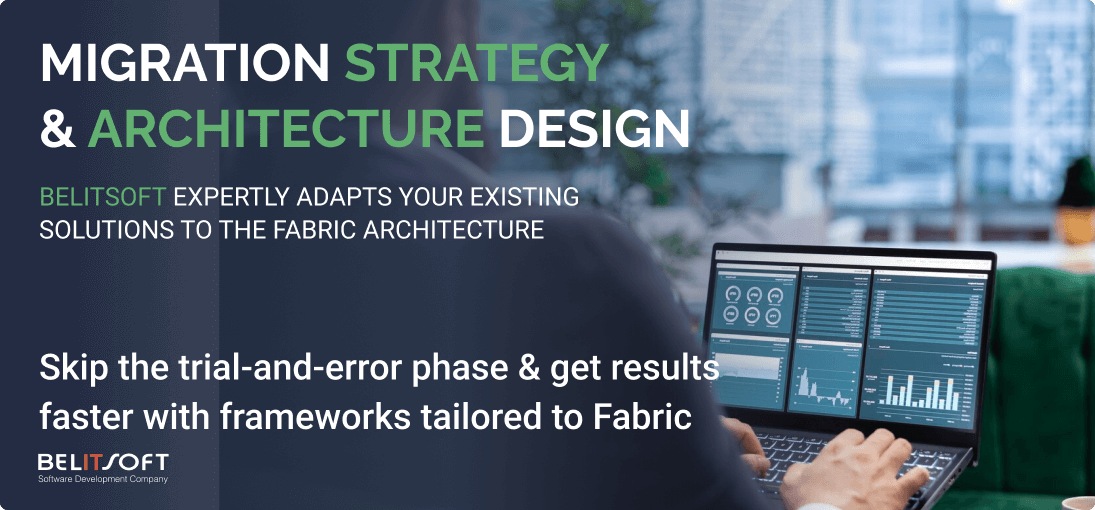
Cross-Functional Collaboration
Fabric brings everyone into the same space: data engineers, BI devs, data scientists. The roles that used to sit apart are now working side by side. That’s why it’s not just a platform shift, it’s a team shift. Companies need to start building cross-disciplinary teams and getting departments to actually collaborate; not just hand stuff off. In some cases, that means spinning up a central DataOps team or a center of excellence to keep things from drifting.
Governance and Data Management
Companies should have or develop capabilities in data governance, security, and compliance that span multiple services. Fabric doesn’t automatically centralize governance across its components, so skills with tools like Microsoft Purview for metadata management and lineage can help fill this gap. Role-based access controls, workspace management, and policies need to be enforced consistently across the unified environment.
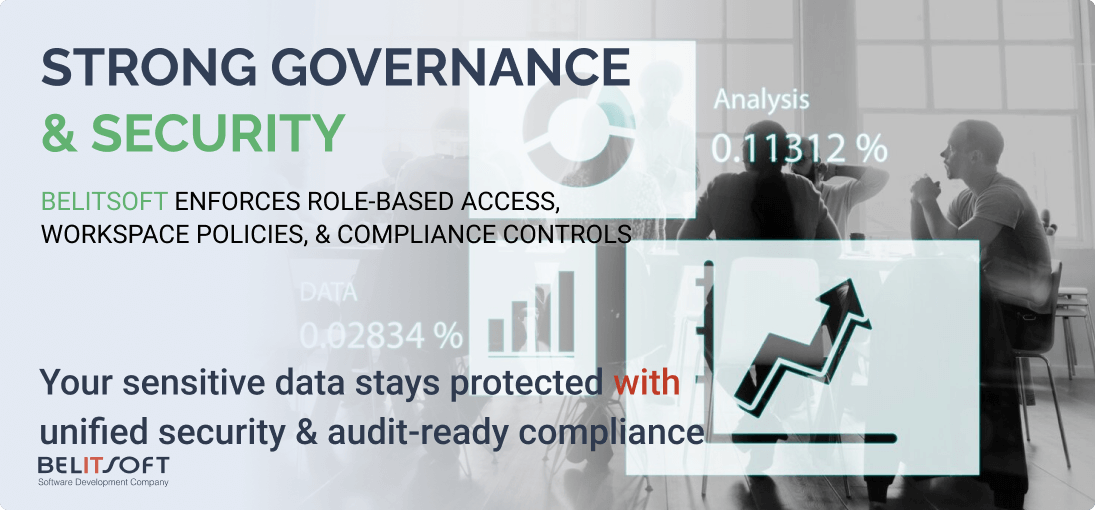
DevOps and Capacity Management
Fabric isn’t set-it-and-forget-it. It runs on Azure capacities, and depending on how you set it up, you might be dealing with a pay-as-you-go model instead of fixed capacity. That means teams need to know how to monitor and tune resource usage: things like how capacity units get eaten up, when to scale, and how to schedule workloads so you are not burning money during off-hours. Without that visibility, performance takes a hit or costs spiral. A FinOps mindset helps here. Someone has got to keep an eye on the meter.
Training and Change Management
Teams used to Power BI will need training on new Fabric features (Spark notebooks, pipeline orchestration, OneLake, etc.). Given the multi-tool complexity of Fabric, investing in upskilling, workshops, or pilot projects will help the workforce adapt. Leadership support and clear communication of the benefits of Fabric will ease the transition for end-users as well as IT staff.
Common Migration Challenges and Pitfalls
Moving from Power BI Premium to Fabric isn’t always smooth. There are plenty of traps teams fall into early on. Knowing what can go wrong helps you plan around it and avoid wasting time (or budget) fixing preventable problems.
Fabric introduces new tools, new architecture, and a different pricing model. That means new skills, planning effort, and real risk if teams go in blind. The pain comes when companies skip the preparation stage.
Tooling Complexity & Skill Gaps
One of the big hurdles with Fabric is the skill gap. It casts a wide net: no single person or team is likely to have it all from the start.
You might have great Power BI and DAX folks, but little to no experience with Spark or Python. That slows things down and leads to underused features.
Mastering Fabric requires expertise across a wide range of tools spanning data engineering, analytics, and BI.
Without serious upskilling, teams risk falling back on old habits, like using the wrong tools for the job or missing what Fabric can actually do.
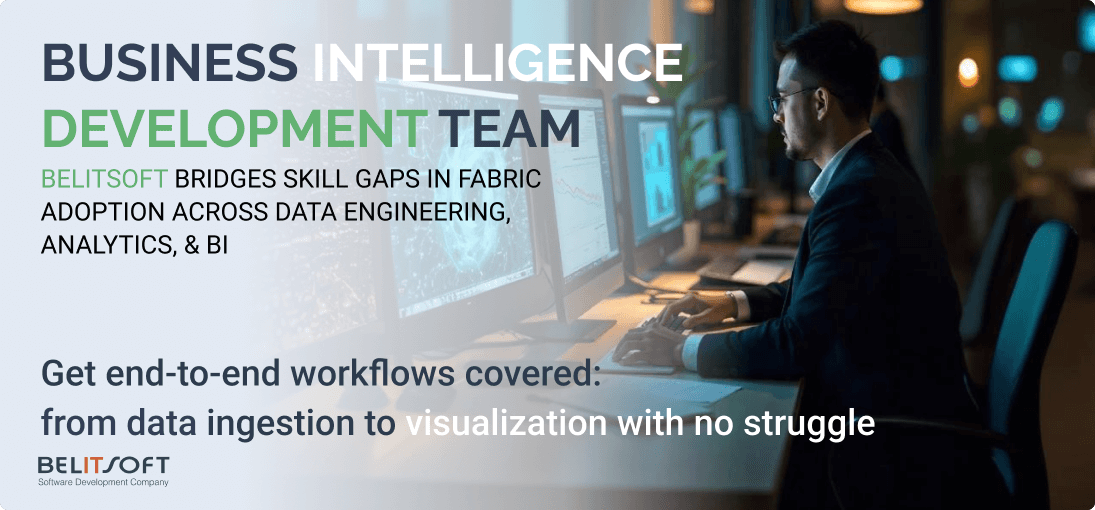
Steep Learning Curve & Lack of Best Practices
Fabric is still new, and the playbook is not fully written yet. Microsoft offers docs and templates (mostly lifted from Synapse and Data Factory) but there is no built-in framework for how to actually structure your projects. You are starting with a blank slate.
That freedom can backfire if teams wing it without clear guidance. Without predefined standards, organizations have to create their own rules: workspace setup, naming conventions, data lake zones, all of it.
And until that settles, most teams go through a trial-and-error phase that slows things down.
Fragmented or Redundant Solutions
Fabric gives you a few different ways to do the same thing, like loading data through Pipelines, Dataflows, or notebooks. That sounds flexible, but it often leads to confusion. Teams start using different tools for the same job, without talking to each other. That is how you end up with duplicate workflows and zero visibility. Unless you set clear rules on what to use and when, things drift fast.
Capacity and Licensing Surprises
Fabric doesn’t use fixed capacity like Power BI Premium. It runs on compute units: scale up, down, pause. You pay for usage.
Sounds fine. Until you get the bill.
Teams pick F32 to save money. But anything below F64 drops free viewing. Now every report needs a Pro license. Under Premium? Included. Under Fabric? Extra cost. And most teams don’t see it coming.
Plenty of companies that switched to F32 thinking they were optimizing costs got hit later with Pro license expenses.
Want the same viewer access as P1? You’ll need at least F64. That can cost 25–70% more, depending on setup.
There are ways to manage it (annual reservations, Azure commit discounts) but only if you plan before migration. Not after.
Data Refresh and Downtime Considerations
The mechanics of migrating workspaces are straightforward (reassigning workspaces to the new capacity), but there are operational gotchas. When you migrate a workspace, any active refresh or query jobs are canceled and must be rerun, and scheduled jobs resume only after migration. If not carefully timed, this could disrupt data refresh schedules. Customers may need to “recreate scheduled jobs” or at least verify them post-migration to ensure continuity. Planning a hybrid migration (running old and new in parallel) can mitigate disruptions.
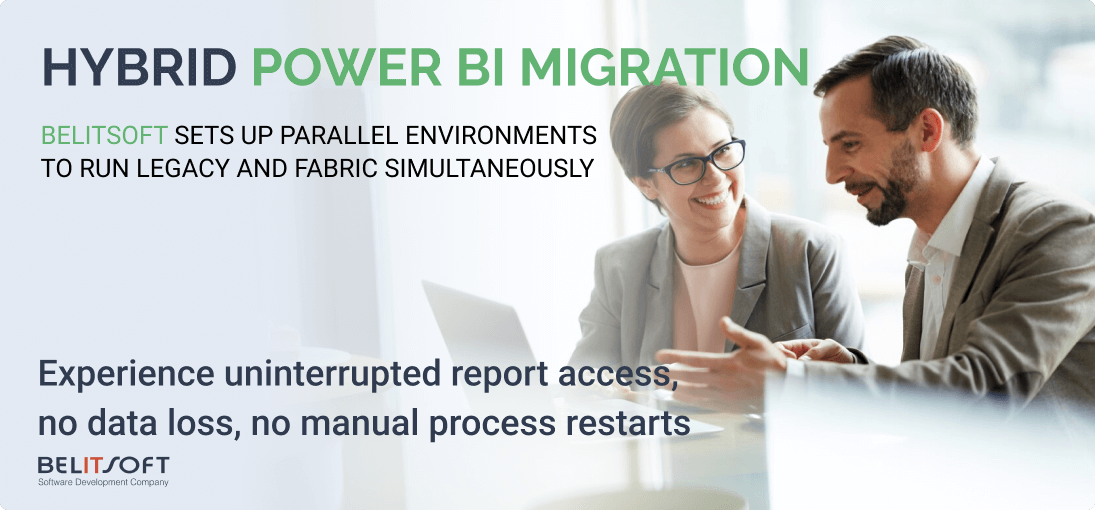
Rely on Belitsoft technology experts to use their in-depth knowledge, broad expertise, and strategic thinking to assist you in legacy migration to Microsoft Fabric, while minimizing downtime and ensuring continuity.
Resource Management Pitfalls
Fabric lets you pause or scale capacity. Sounds like a good way to save money. But when a capacity is paused, nothing runs — not even imported datasets. Reports go dark.
Companies with global teams or 24/7 access needs quickly learn: pausing overnight isn’t an option.
There’s another catch: all workloads share the same compute pool. So if a heavy Spark job or dataflow kicks off, it can choke your BI reports unless you plan around it.
Premium users didn’t have to think about this: those systems were separate. Now it’s on you to tune compute (CUs), schedule jobs smartly, and monitor usage in real time.
Ignore that, and you’ll hit capacity walls: slow reports, failed jobs, or both.
Pricing and Licensing Differences
One of the biggest changes in moving to Fabric is the pricing and licensing model. Below is a comparison of key differences between Power BI Premium (per capacity) and Microsoft Fabric.
| Aspect | Power BI Premium (P SKUs) | Microsoft Fabric (F SKUs) |
| Capacities and Scale | Fixed capacity tiers P1–P5 (e.g. P1 = 8 v-cores). No smaller tier below P1. Scaling requires purchasing the next tier up. | Flexible capacity sizes (F2, F4, F8, F32, F64, F128, …). Can choose much smaller units than old P1 if needed. Supports scaling out or pausing capacity in Azure portal. |
| Included Workloads | Analytics limited to Power BI (datasets, reports, dashboards, AI visuals, some dataflows). Other services (ETL, data science) require separate Azure products. | All-in-one platform: Includes Power BI (equivalent to Premium features) plus Synapse (Spark, SQL), Data Factory, real-time analytics, OneLake, etc. Superset of data capabilities. |
| User Access Model | Unlimited report consumption by free users on content in a Premium workspace (no per-user license needed for viewers). | Unlimited free-user consumption only on F64 and above. Smaller SKUs require Pro/PPU licenses for viewers. |
| On-Premises Report Server | Power BI Report Server (PBIRS) included with P1–P5 as dual-use right. | PBIRS included with F64+ reserved capacity. Pay-as-you-go SKUs need separate license. |
| Purchase & Billing | Purchased via M365 admin center as subscription (monthly/annually). Fixed cost. Not counted toward Azure commitments. | Purchased via Azure (Portal or subscription). Pay-as-you-go or reserved. Eligible for Azure Consumption Commitments (MACC). |
| Cost Level (Capacity) | P1 = $4,995/month. Higher SKUs scale linearly (P2 ~$10k, P3 ~$20k). | F64 = ~$8,409.60/month pay-as-you-go. F32 = ~$4,204.80/month. More features included. |
| Scaling and Pausing | No dynamic scaling. Capacity is always running. No pause option. | Can scale up/down or pause capacity in Azure. Pausing stops charges but also suspends access. |
| Future Roadmap | Power BI Premium per capacity is being phased out (no new purchases after 2024; sunset in 2025). | Fabric is the future. All new features (Direct Lake, Copilot, OneLake) are in Fabric. |
Key takeaways on pricing/licensing
Existing Power BI Premium customers will need to transition to an F SKU at their renewal (unless on a special agreement). In doing so, they should prepare for potential cost increases at equivalent capacity levels, although Fabric’s flexibility (smaller SKUs or scaling down) can offset some costs if used wisely.
The benefits of Fabric’s model include more granular scaling, alignment with Azure billing (useful if you have Azure credits), and access to a broader set of tools under one price.
The downsides include complexity in cost management and the need to adjust to Azure’s billing cycle.
Careful analysis is recommended to choose the right capacity (F SKU) so that performance and user access needs are met without overspending.
Use Cases and Success Stories of Fabric Migration
Several organizations have already made the leap from Power BI Premium to Microsoft Fabric. These real-world case studies highlight the motivations for migration and the benefits achieved.
Flora Food Group – Consolidation and Real-Time Insights
Flora Food Group, a global plant-based food company, was juggling Synapse, Data Factory, and Power BI as separate tools. Too many moving parts. They decided to consolidate everything into Fabric.
The move wasn’t rushed. They ran Fabric alongside their legacy stack and started with the big datasets. They used a medallion architecture (bronze-silver-gold) in OneLake to build a single source of truth.
From there, the upside came fast:
- Unified setup — reporting, engineering, science, and security in one stack
- Better reporting — centralized semantic models made data reuse easy
- Direct Lake — killed the need for scheduled refreshes; reports now pull fresh data near real time
- Lower waste — idle compute from one workload now powers another
- Faster BI teams — integrated tools meant fewer handoffs and less prep time
According to their Head of Data & Insight, the migration simplified their architecture and cut costs, while boosting capability. They see it as a strategic step toward what’s next: AI-powered analytics with Fabric Copilot.
BDO Belgium – Scalable Analytics for Mergers & Acquisitions
BDO Belgium was hitting walls with Power BI Premium, especially during M&A due diligence, where speed and clarity are non-negotiable.
So they built a new analytics platform on Fabric. They called it Data Eyes.
The shift paid off:
- Faster insights — better performance on large, complex datasets
- Self-service access — finance teams explored data without writing code
- One interface — familiar to users, powerful at scale
- Simpler backend — IT maintains one platform, not a patchwork
Fabric gave them what Power BI alone couldn’t: a system that handles scale and puts data in the hands of non-technical users.
For BDO, it wasn’t just an upgrade; it changed how the business works with data.
Other Early Adopters
Many organizations that were already invested in the Microsoft data stack find Fabric a natural progression.
Some companies reported that Fabric’s unified approach streamlined their data engineering pipelines and BI. They cite benefits like reducing data duplication (thanks to OneLake) and easier enforcement of security in one place rather than across multiple services.
Fabric’s integration of AI (Copilot for data analysis) is seen as an advantage.
The pattern is that companies migrating from Power BI Premium experience improvements in data freshness, collaboration, and total cost of ownership when they leverage the full Fabric ecosystem of tools.
Value comes from utilizing Fabric’s broader capabilities rather than treating it as a like-for-like replacement of Power BI Premium.
Organizations that approach the migration as an opportunity to modernize their data architecture (as Flora did with medallion architecture and real-time data, or BDO did with an intuitive analytics app) tend to reap the most benefits. They achieve not just a seamless transition of existing reports, but also new insights and efficiencies that were previously difficult or impossible with the siloed tool approach.
Implications of Not Migrating to Fabric
Given Microsoft’s strategic direction, companies that choose not to migrate from Power BI Premium to Fabric face several implications in terms of features, support, and long-term viability.
Feature Limitations
Fabric isn’t just the next version of Power BI. It’s a superset. Staying on Power BI Premium means missing the features Microsoft is building for the future.
No OneLake. No Direct Lake. No unified data layer. No Spark workloads. No Copilot. No built-in AI. Those are Fabric-only.
If you stay on Premium, your analytics stack stays frozen. Fabric keeps evolving: with deeper integration, faster performance, and cloud-scale features.
You can bolt on Azure services to replicate some of it, but that means extra setup, extra cost, and more moving parts.
Support and Updates
Microsoft is ending Power BI Premium per capacity SKUs. New purchases stop mid-2024. Renewals end in 2025.
What that means: you’ll need to move to Fabric if you want to keep using the platform.
There’s a temporary bridge: existing Premium customers can access some Fabric features inside their current capacity. But that’s a short-term patch. Not a strategy.
Once your legacy agreement runs out, so does your support. No new features. No roadmap. Just a countdown to disruption.
Fabric is the future. Microsoft’s made that clear.
Potential Cost of Inaction
Delaying Fabric may seem easier in the short term, but the cost shifts elsewhere.
Power BI Report Server won’t be bundled once Premium SKUs are retired. It will require separate licensing through SQL Server Enterprise + SA.
Fabric also consolidates multiple tools (ETL, warehouse, reporting) into a single platform. Staying on the old stack means paying for them separately.
Microsoft is offering 30 days of free Fabric capacity during transition. After that, migration gets more expensive and less flexible.
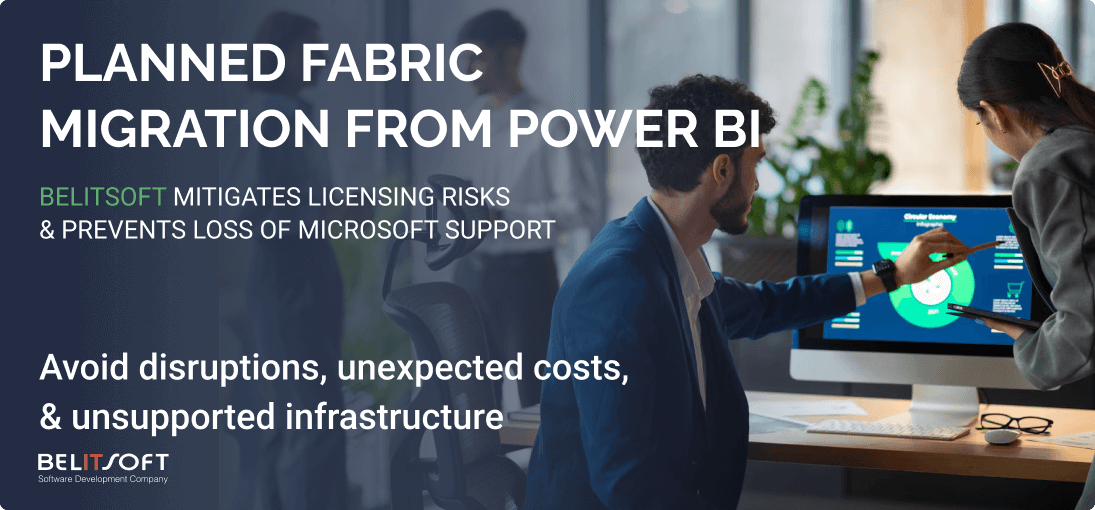
Long-Term Roadmap Alignment
After 2025, support for legacy Premium issues could slow down - because engineering focus will be on Fabric. Eventually, the Power BI Premium brand itself may disappear.
Holdouts will face a bigger, messier migration later: with more change to absorb, less time to adapt.
Early movers get the opposite: smoother transition, room to adjust, and a seat at the table. Microsoft is still shaping Fabric. Companies that migrate now can influence what comes next.
Choosing not to migrate to Fabric is not a risk-free stance. In the immediate term (for those with existing Premium deployments), it means missing out on new capabilities and efficiencies. In the medium term (by 2025), it becomes a support risk as the old licensing model is phased out. While organizations can continue with Power BI Pro or Premium Per User for basic needs (these are not impacted by the capacity SKU retirement), larger scale analytics initiatives will increasingly require Fabric to stay on the cutting edge.
Therefore, companies should weigh the cost of migration against the cost of stagnation. Most will find that a planned migration, even if challenging, is the prudent path to ensure they remain supported and competitive in their analytics capabilities.
How Belitsoft can Help
Fabric migration touches architecture, governance, training, and cost models.
Experienced providers like Belitsoft have built services around it: assessment, design, workspace migration, policy setup, user onboarding. All mapped to Fabric’s structure.
We use automation and phased rollout to reduce downtime and avoid rework.
Engagements are flexible: fixed-price or T&M, depending on environment size and scope.
With the right setup, you'll move faster and start using unified workloads, AI features, and performance gains.
Fabric requires a diverse skill set spanning Power BI, SQL, Python, Spark, Delta Lake, and data engineering, far beyond traditional dashboard development. By outsourcing our BI development services, you get dedicated BI and data engineering experts with hands-on experience in Power BI modernization and migration to ensure a smooth transition, while introducing automated pipelines and AI-driven analytics. Contact for a consultation.
Rate this article
Recommended posts
Portfolio

Our Clients' Feedback


















.jpg)
.jpg)
.jpg)
.jpg)
.jpg)
.jpg)
.jpg)
.jpg)
.jpg)
.jpg)



















We have been working for over 10 years and they have become our long-term technology partner. Any software development, programming, or design needs we have had, Belitsoft company has always been able to handle this for us.
Founder from ZensAI (Microsoft)/ formerly Elearningforce